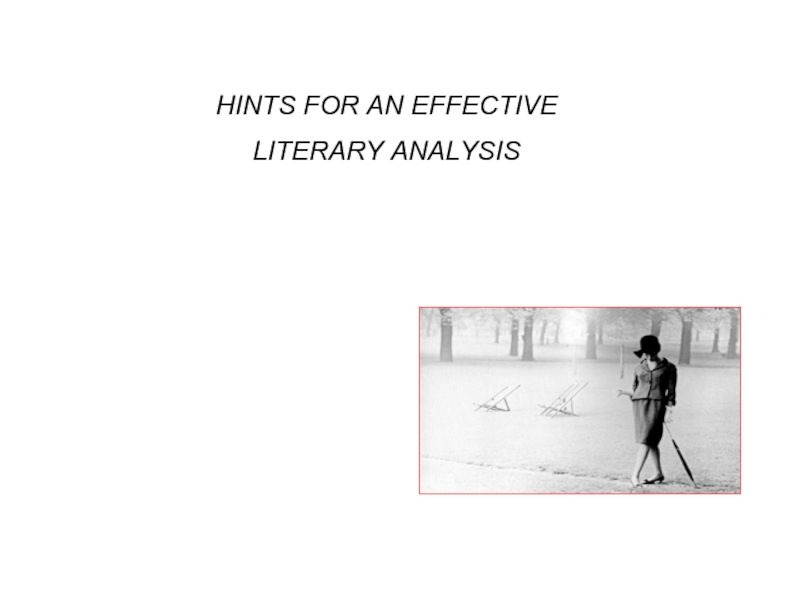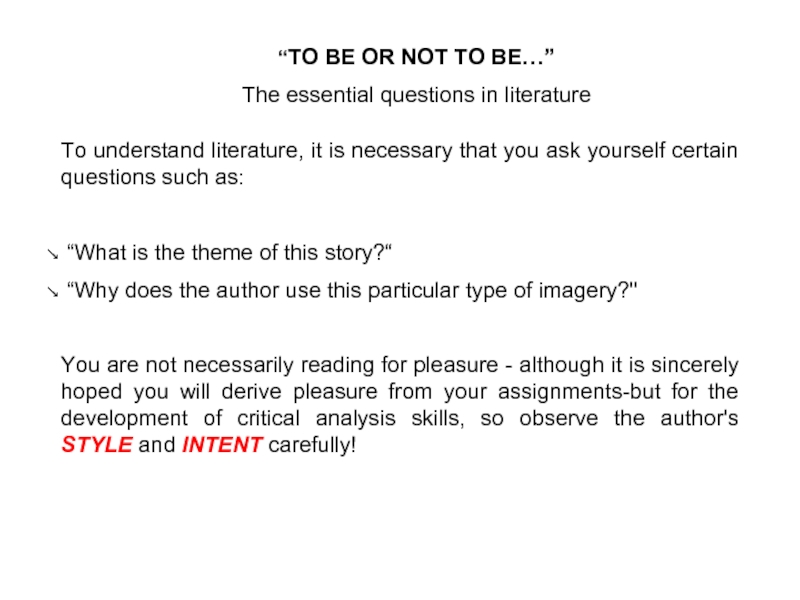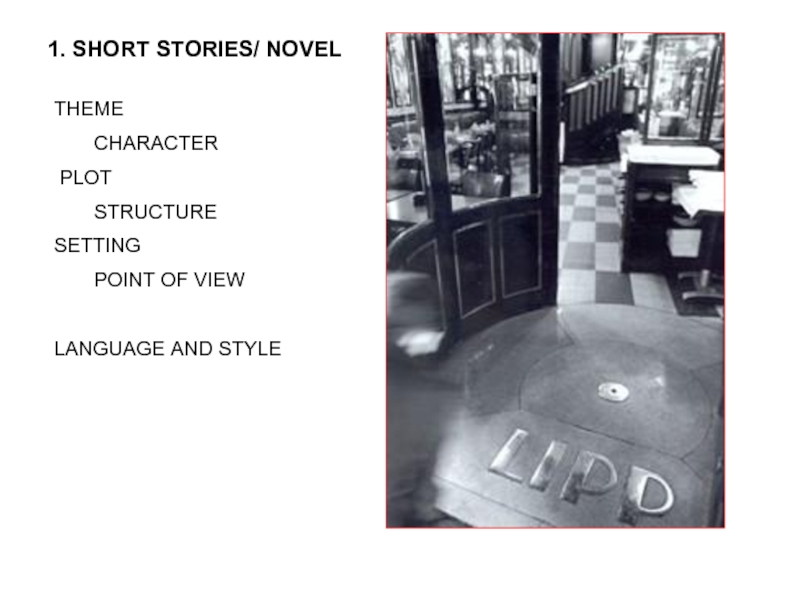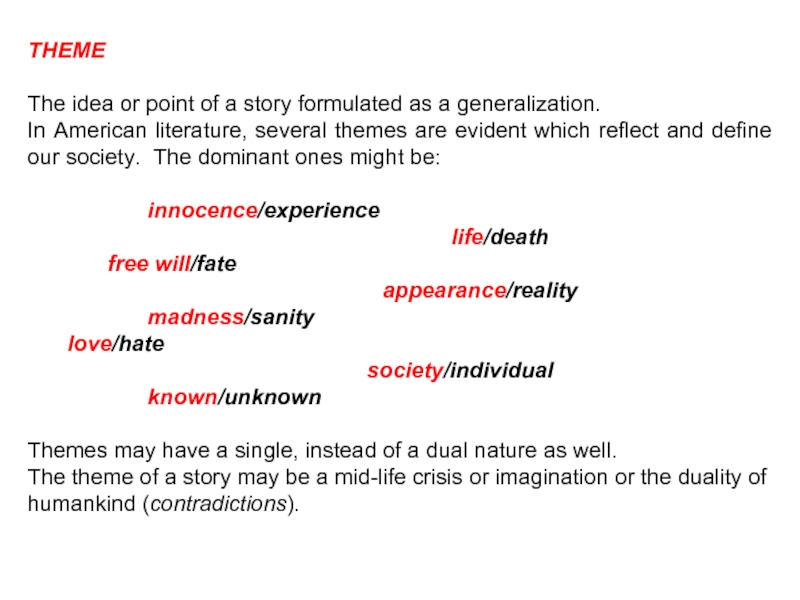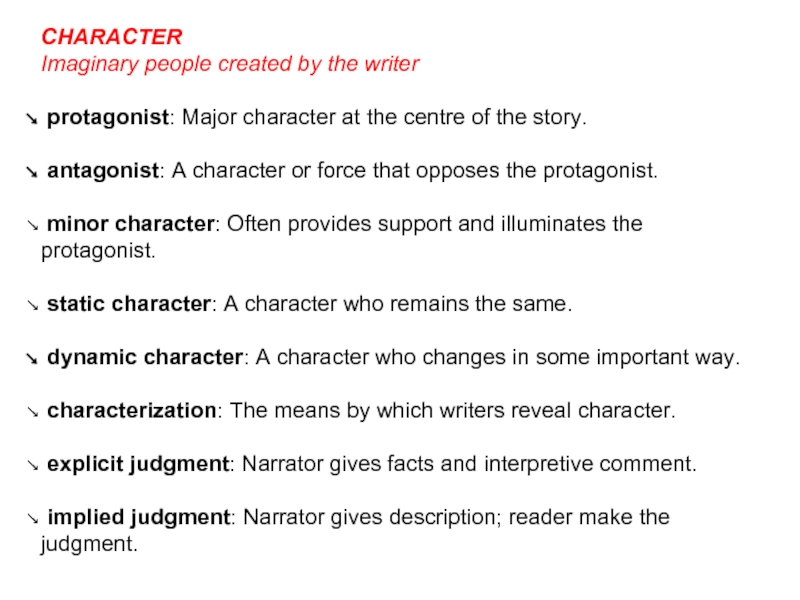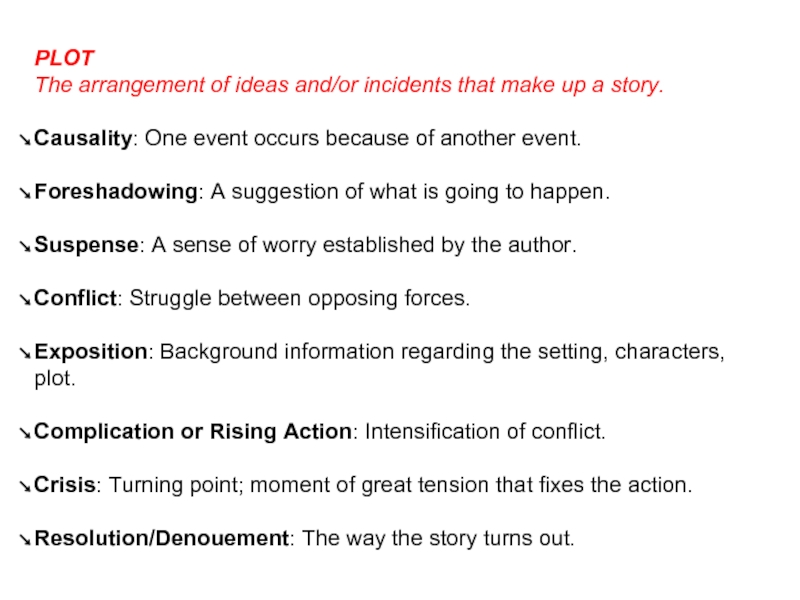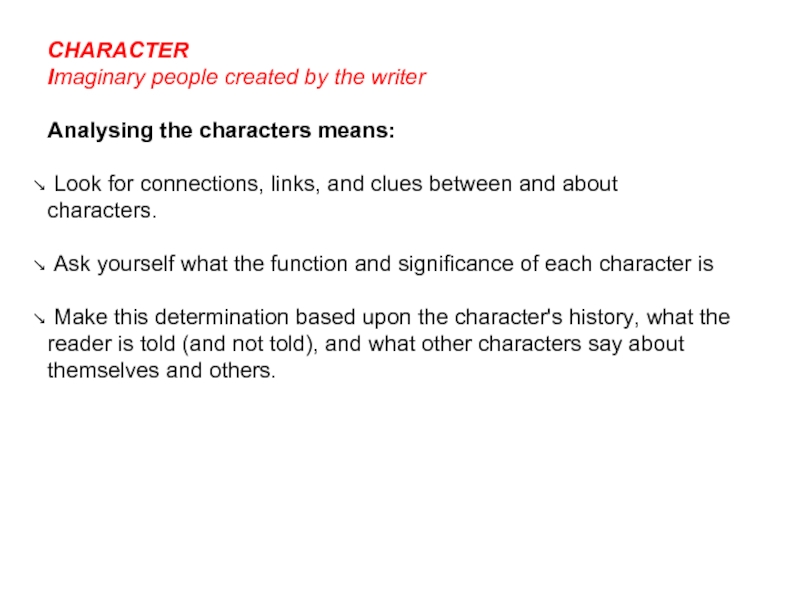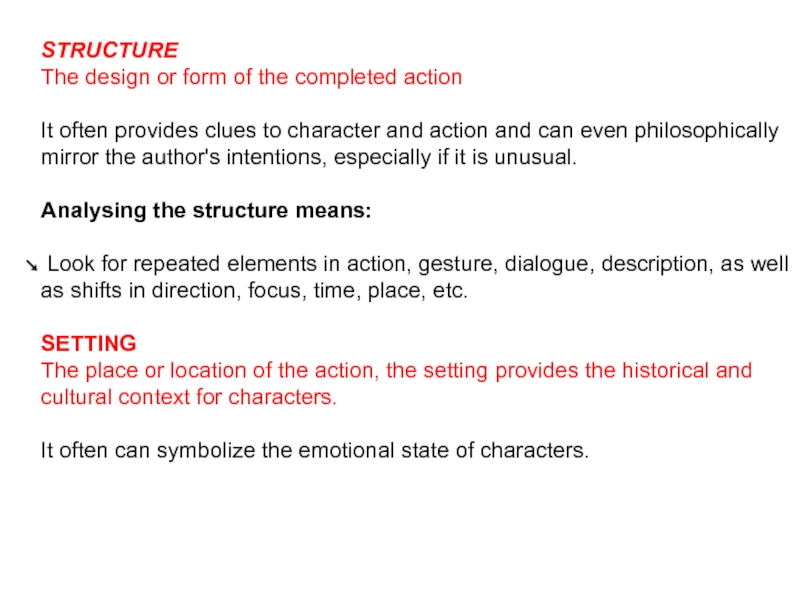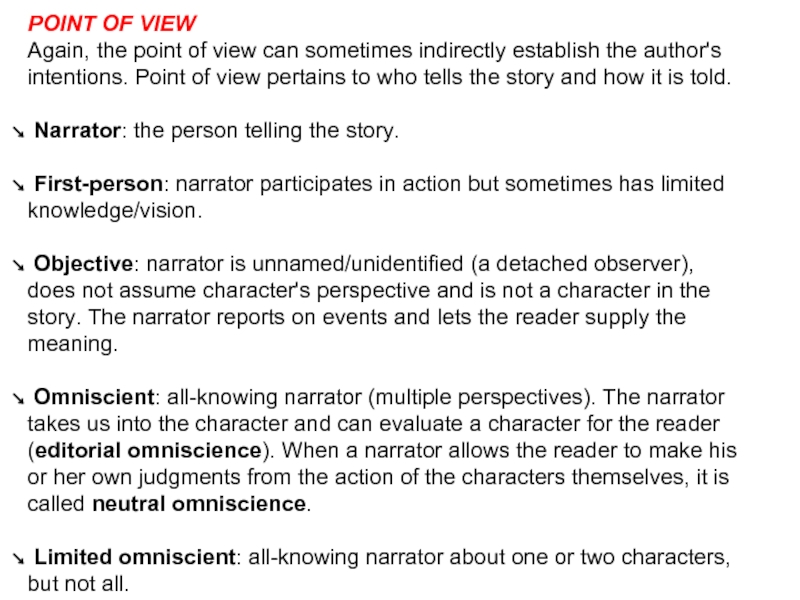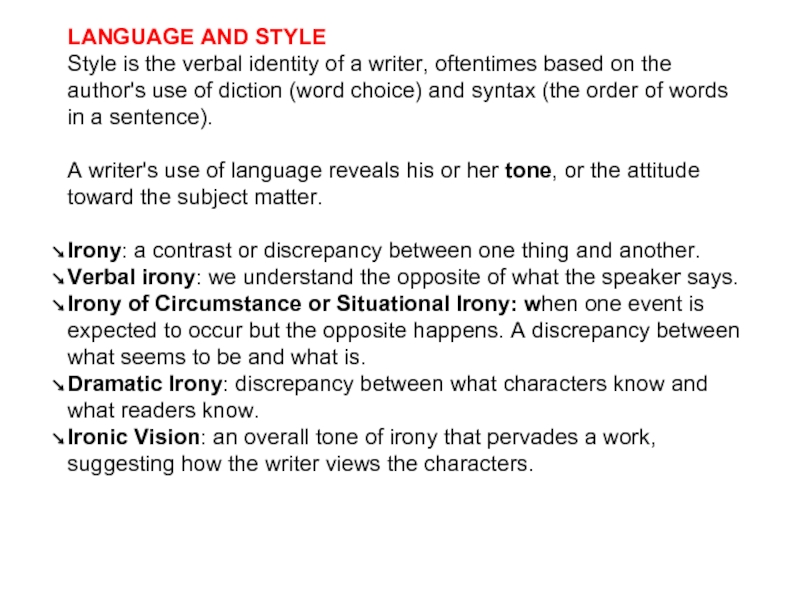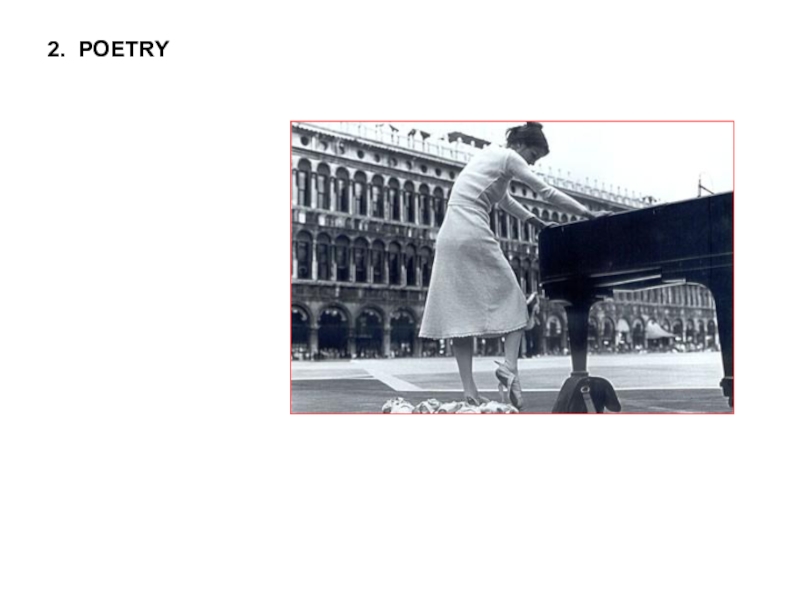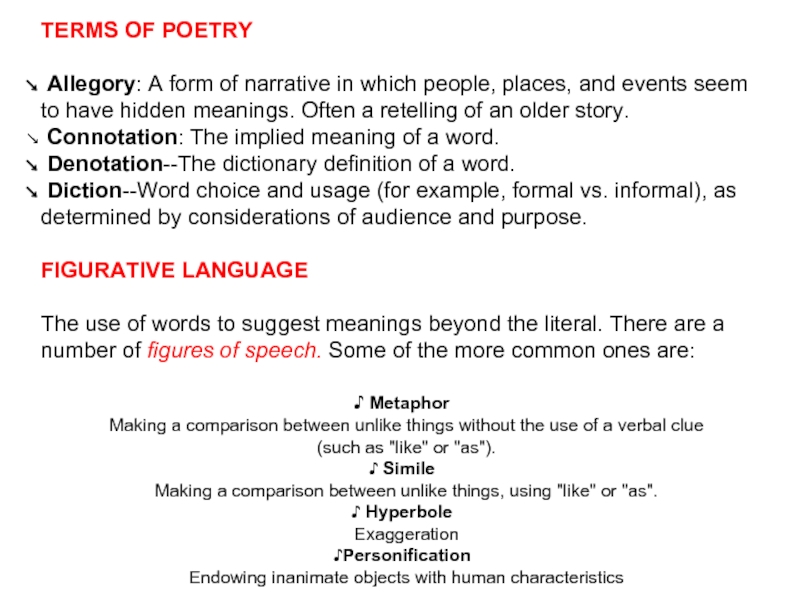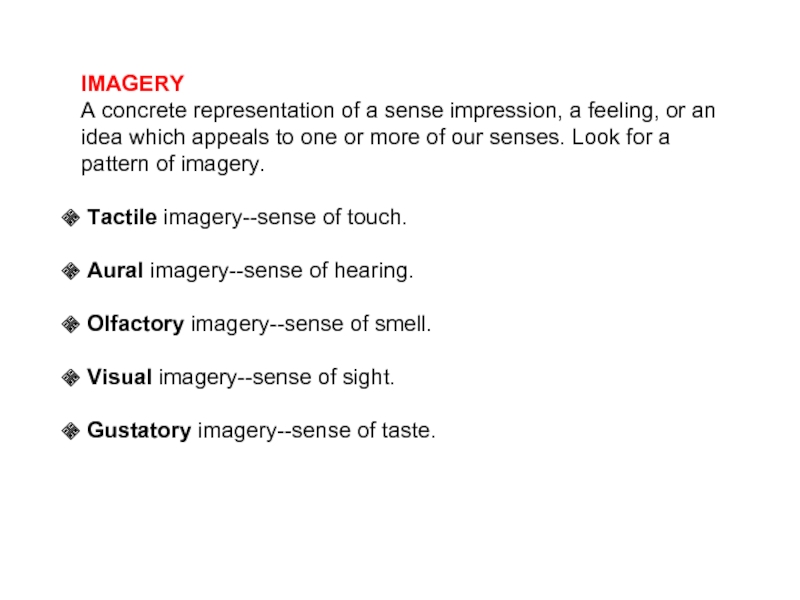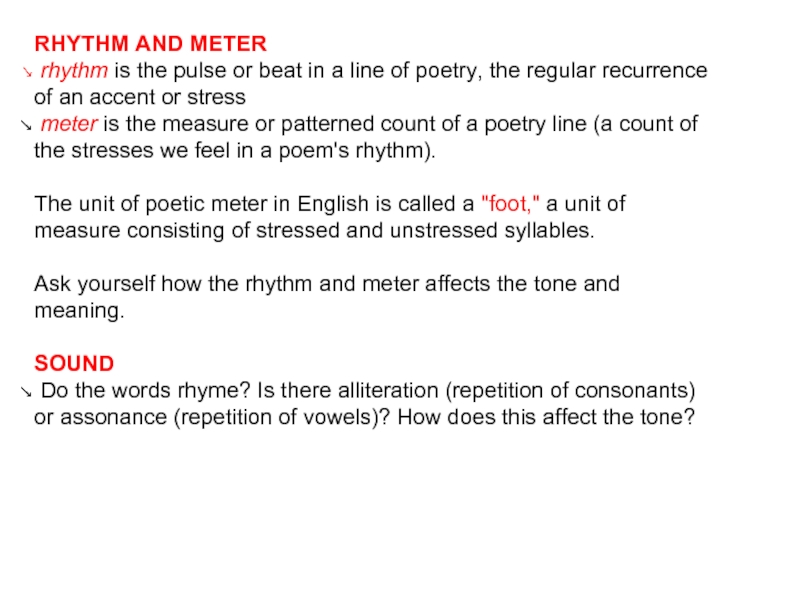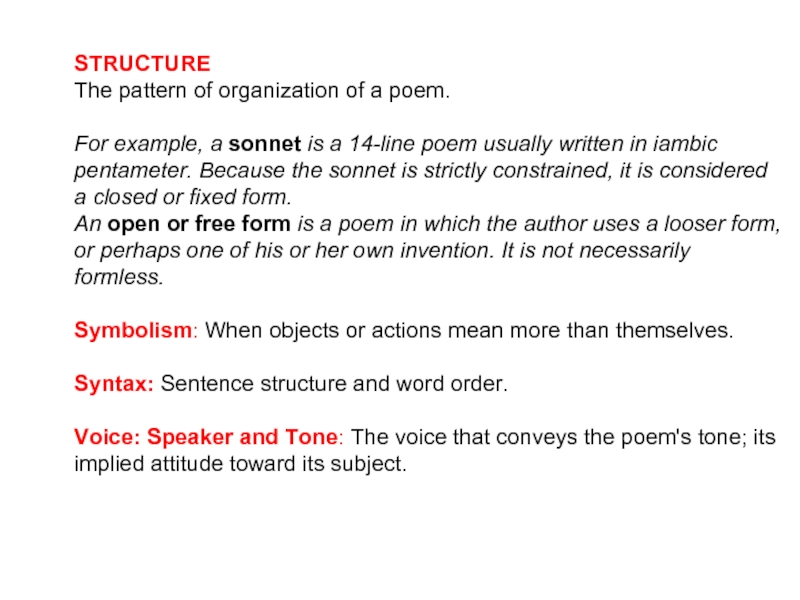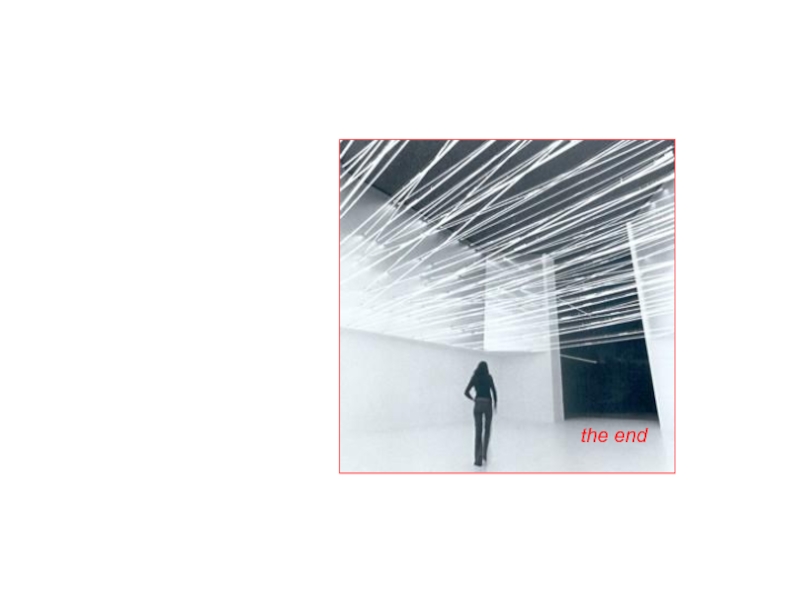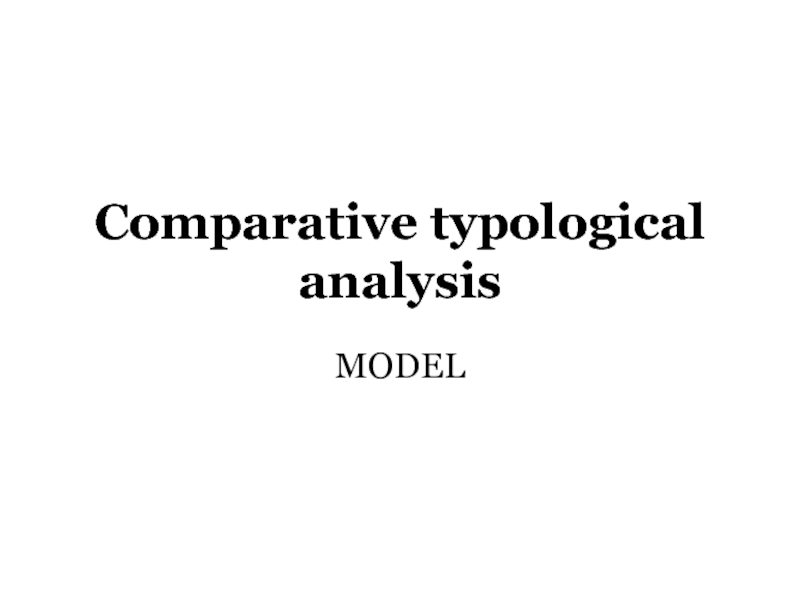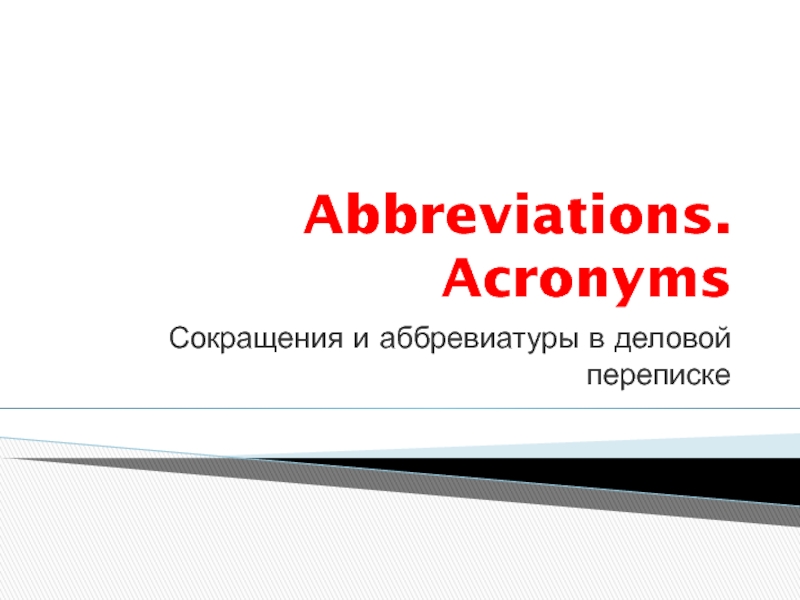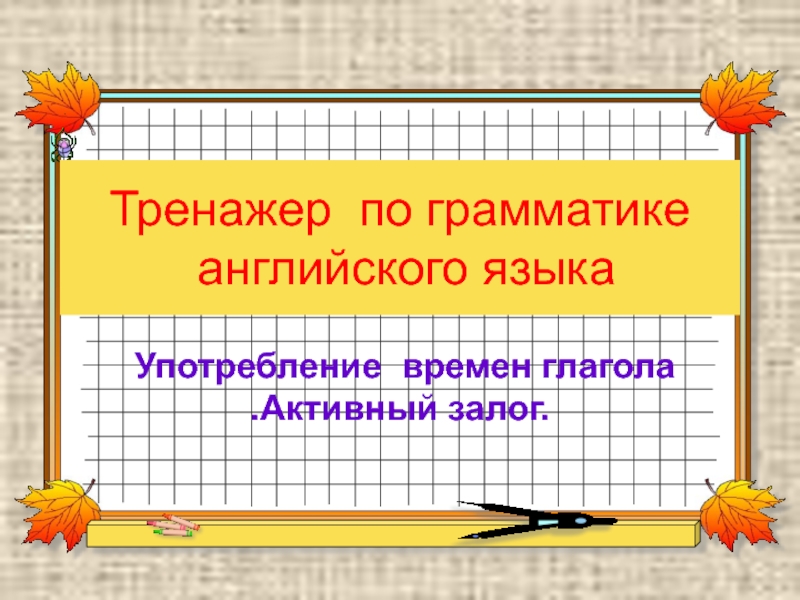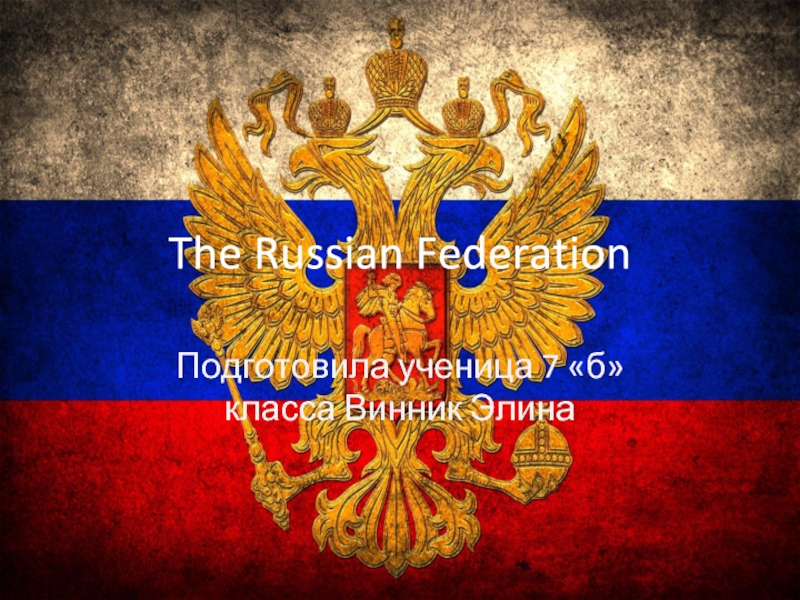- Главная
- Разное
- Дизайн
- Бизнес и предпринимательство
- Аналитика
- Образование
- Развлечения
- Красота и здоровье
- Финансы
- Государство
- Путешествия
- Спорт
- Недвижимость
- Армия
- Графика
- Культурология
- Еда и кулинария
- Лингвистика
- Английский язык
- Астрономия
- Алгебра
- Биология
- География
- Детские презентации
- Информатика
- История
- Литература
- Маркетинг
- Математика
- Медицина
- Менеджмент
- Музыка
- МХК
- Немецкий язык
- ОБЖ
- Обществознание
- Окружающий мир
- Педагогика
- Русский язык
- Технология
- Физика
- Философия
- Химия
- Шаблоны, картинки для презентаций
- Экология
- Экономика
- Юриспруденция
Hints for an effective. Literary analysis презентация
Содержание
- 1. Hints for an effective. Literary analysis
- 2. My soul roams with the sea, the
- 3. To understand literature, it is necessary that
- 4. 1. SHORT STORIES/ NOVEL THEME CHARACTER
- 5. THEME The idea or point of
- 6. CHARACTER Imaginary people created by the
- 7. PLOT The arrangement of ideas and/or incidents
- 8. CHARACTER Imaginary people created by the
- 9. STRUCTURE The design or form of the
- 10. POINT OF VIEW Again, the point of
- 11. LANGUAGE AND STYLE Style is the verbal
- 12. 2. POETRY
- 13. TERMS OF POETRY Allegory:
- 14. IMAGERY A concrete representation of a sense
- 15. RHYTHM AND METER rhythm is the
- 16. STRUCTURE The pattern of organization of a
- 17. the end
Слайд 2My soul roams with the sea, the whales’
Home, wandering to
the widest corners
Of the world, returning ravenous with desire,
Flying solitary, screaming, exciting me
To the open ocean, breaking oaths
On the curve
Of a wave,
Anonymous,
The Seafarer _____The origins 700 B.C. – 1066 A.D.
Of the world, returning ravenous with desire,
Flying solitary, screaming, exciting me
To the open ocean, breaking oaths
On the curve
Of a wave,
Anonymous,
The Seafarer _____The origins 700 B.C. – 1066 A.D.
Слайд 3To understand literature, it is necessary that you ask yourself certain
questions such as:
“What is the theme of this story?“
“Why does the author use this particular type of imagery?"
You are not necessarily reading for pleasure - although it is sincerely hoped you will derive pleasure from your assignments-but for the development of critical analysis skills, so observe the author's STYLE and INTENT carefully!
“What is the theme of this story?“
“Why does the author use this particular type of imagery?"
You are not necessarily reading for pleasure - although it is sincerely hoped you will derive pleasure from your assignments-but for the development of critical analysis skills, so observe the author's STYLE and INTENT carefully!
“TO BE OR NOT TO BE…”
The essential questions in literature
Слайд 41. SHORT STORIES/ NOVEL
THEME
CHARACTER
PLOT
STRUCTURE
SETTING
POINT OF VIEW
LANGUAGE AND
STYLE
Слайд 5THEME
The idea or point of a story formulated as a generalization.
In American literature, several themes are evident which reflect and define our society. The dominant ones might be:
innocence/experience
life/death
free will/fate
appearance/reality
madness/sanity
love/hate
society/individual
known/unknown
Themes may have a single, instead of a dual nature as well.
The theme of a story may be a mid-life crisis or imagination or the duality of humankind (contradictions).
Слайд 6
CHARACTER
Imaginary people created by the writer
protagonist: Major character at the
centre of the story.
antagonist: A character or force that opposes the protagonist.
minor character: Often provides support and illuminates the protagonist.
static character: A character who remains the same.
dynamic character: A character who changes in some important way.
characterization: The means by which writers reveal character.
explicit judgment: Narrator gives facts and interpretive comment.
implied judgment: Narrator gives description; reader make the judgment.
antagonist: A character or force that opposes the protagonist.
minor character: Often provides support and illuminates the protagonist.
static character: A character who remains the same.
dynamic character: A character who changes in some important way.
characterization: The means by which writers reveal character.
explicit judgment: Narrator gives facts and interpretive comment.
implied judgment: Narrator gives description; reader make the judgment.
Слайд 7PLOT
The arrangement of ideas and/or incidents that make up a story.
Causality: One event occurs because of another event.
Foreshadowing: A suggestion of what is going to happen.
Suspense: A sense of worry established by the author.
Conflict: Struggle between opposing forces.
Exposition: Background information regarding the setting, characters, plot.
Complication or Rising Action: Intensification of conflict.
Crisis: Turning point; moment of great tension that fixes the action.
Resolution/Denouement: The way the story turns out.
Слайд 8
CHARACTER
Imaginary people created by the writer
Analysing the characters means:
Look
for connections, links, and clues between and about characters.
Ask yourself what the function and significance of each character is
Make this determination based upon the character's history, what the reader is told (and not told), and what other characters say about themselves and others.
Ask yourself what the function and significance of each character is
Make this determination based upon the character's history, what the reader is told (and not told), and what other characters say about themselves and others.
Слайд 9STRUCTURE
The design or form of the completed action
It often provides clues
to character and action and can even philosophically mirror the author's intentions, especially if it is unusual.
Analysing the structure means:
Look for repeated elements in action, gesture, dialogue, description, as well as shifts in direction, focus, time, place, etc.
SETTING
The place or location of the action, the setting provides the historical and cultural context for characters.
It often can symbolize the emotional state of characters.
Analysing the structure means:
Look for repeated elements in action, gesture, dialogue, description, as well as shifts in direction, focus, time, place, etc.
SETTING
The place or location of the action, the setting provides the historical and cultural context for characters.
It often can symbolize the emotional state of characters.
Слайд 10POINT OF VIEW
Again, the point of view can sometimes indirectly establish
the author's intentions. Point of view pertains to who tells the story and how it is told.
Narrator: the person telling the story.
First-person: narrator participates in action but sometimes has limited knowledge/vision.
Objective: narrator is unnamed/unidentified (a detached observer), does not assume character's perspective and is not a character in the story. The narrator reports on events and lets the reader supply the meaning.
Omniscient: all-knowing narrator (multiple perspectives). The narrator takes us into the character and can evaluate a character for the reader (editorial omniscience). When a narrator allows the reader to make his or her own judgments from the action of the characters themselves, it is called neutral omniscience.
Limited omniscient: all-knowing narrator about one or two characters, but not all.
Narrator: the person telling the story.
First-person: narrator participates in action but sometimes has limited knowledge/vision.
Objective: narrator is unnamed/unidentified (a detached observer), does not assume character's perspective and is not a character in the story. The narrator reports on events and lets the reader supply the meaning.
Omniscient: all-knowing narrator (multiple perspectives). The narrator takes us into the character and can evaluate a character for the reader (editorial omniscience). When a narrator allows the reader to make his or her own judgments from the action of the characters themselves, it is called neutral omniscience.
Limited omniscient: all-knowing narrator about one or two characters, but not all.
Слайд 11LANGUAGE AND STYLE
Style is the verbal identity of a writer, oftentimes
based on the author's use of diction (word choice) and syntax (the order of words in a sentence).
A writer's use of language reveals his or her tone, or the attitude toward the subject matter.
Irony: a contrast or discrepancy between one thing and another.
Verbal irony: we understand the opposite of what the speaker says.
Irony of Circumstance or Situational Irony: when one event is expected to occur but the opposite happens. A discrepancy between what seems to be and what is.
Dramatic Irony: discrepancy between what characters know and what readers know.
Ironic Vision: an overall tone of irony that pervades a work, suggesting how the writer views the characters.
A writer's use of language reveals his or her tone, or the attitude toward the subject matter.
Irony: a contrast or discrepancy between one thing and another.
Verbal irony: we understand the opposite of what the speaker says.
Irony of Circumstance or Situational Irony: when one event is expected to occur but the opposite happens. A discrepancy between what seems to be and what is.
Dramatic Irony: discrepancy between what characters know and what readers know.
Ironic Vision: an overall tone of irony that pervades a work, suggesting how the writer views the characters.
Слайд 13
TERMS OF POETRY
Allegory: A form of narrative in which people,
places, and events seem to have hidden meanings. Often a retelling of an older story.
Connotation: The implied meaning of a word.
Denotation--The dictionary definition of a word.
Diction--Word choice and usage (for example, formal vs. informal), as determined by considerations of audience and purpose.
FIGURATIVE LANGUAGE
The use of words to suggest meanings beyond the literal. There are a number of figures of speech. Some of the more common ones are:
Metaphor
Making a comparison between unlike things without the use of a verbal clue
(such as "like" or "as").
Simile
Making a comparison between unlike things, using "like" or "as".
Hyperbole
Exaggeration
Personification
Endowing inanimate objects with human characteristics
Connotation: The implied meaning of a word.
Denotation--The dictionary definition of a word.
Diction--Word choice and usage (for example, formal vs. informal), as determined by considerations of audience and purpose.
FIGURATIVE LANGUAGE
The use of words to suggest meanings beyond the literal. There are a number of figures of speech. Some of the more common ones are:
Metaphor
Making a comparison between unlike things without the use of a verbal clue
(such as "like" or "as").
Simile
Making a comparison between unlike things, using "like" or "as".
Hyperbole
Exaggeration
Personification
Endowing inanimate objects with human characteristics
Слайд 14IMAGERY
A concrete representation of a sense impression, a feeling, or an
idea which appeals to one or more of our senses. Look for a pattern of imagery.
Tactile imagery--sense of touch.
Aural imagery--sense of hearing.
Olfactory imagery--sense of smell.
Visual imagery--sense of sight.
Gustatory imagery--sense of taste.
Tactile imagery--sense of touch.
Aural imagery--sense of hearing.
Olfactory imagery--sense of smell.
Visual imagery--sense of sight.
Gustatory imagery--sense of taste.
Слайд 15RHYTHM AND METER
rhythm is the pulse or beat in a
line of poetry, the regular recurrence of an accent or stress
meter is the measure or patterned count of a poetry line (a count of the stresses we feel in a poem's rhythm).
The unit of poetic meter in English is called a "foot," a unit of measure consisting of stressed and unstressed syllables.
Ask yourself how the rhythm and meter affects the tone and meaning.
SOUND
Do the words rhyme? Is there alliteration (repetition of consonants) or assonance (repetition of vowels)? How does this affect the tone?
meter is the measure or patterned count of a poetry line (a count of the stresses we feel in a poem's rhythm).
The unit of poetic meter in English is called a "foot," a unit of measure consisting of stressed and unstressed syllables.
Ask yourself how the rhythm and meter affects the tone and meaning.
SOUND
Do the words rhyme? Is there alliteration (repetition of consonants) or assonance (repetition of vowels)? How does this affect the tone?
Слайд 16STRUCTURE
The pattern of organization of a poem.
For example, a sonnet is
a 14-line poem usually written in iambic pentameter. Because the sonnet is strictly constrained, it is considered a closed or fixed form.
An open or free form is a poem in which the author uses a looser form, or perhaps one of his or her own invention. It is not necessarily formless.
Symbolism: When objects or actions mean more than themselves.
Syntax: Sentence structure and word order.
Voice: Speaker and Tone: The voice that conveys the poem's tone; its implied attitude toward its subject.
An open or free form is a poem in which the author uses a looser form, or perhaps one of his or her own invention. It is not necessarily formless.
Symbolism: When objects or actions mean more than themselves.
Syntax: Sentence structure and word order.
Voice: Speaker and Tone: The voice that conveys the poem's tone; its implied attitude toward its subject.
